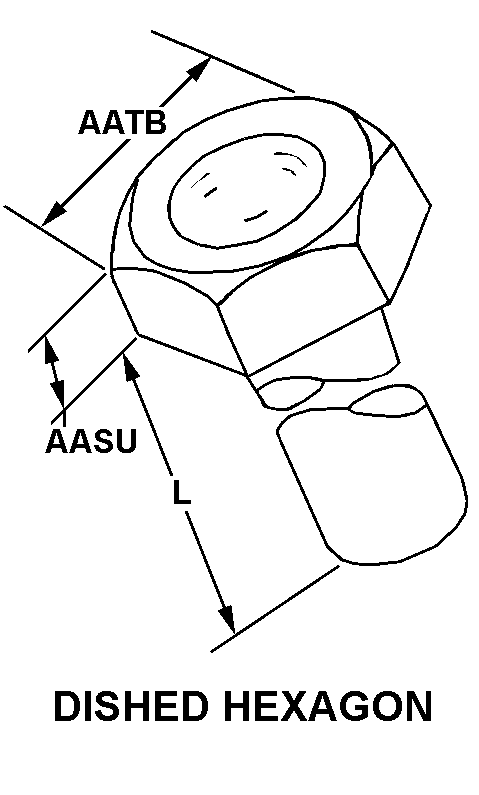5306013082842
Price Quote Get an up to date pricing and availability quote for this product. Order online or over the phone.
Quality Commitment
Serving our customers with quality and safety first.
- AS9120 Certified
- Audited supply chain
- ITAR Registered
- DDTC Registered
- HAZMAT Certified
- Customer service objectives
- Every product 100% inspected

5306-01-308-2842 Specification Set by the OEM (see RNCC code 3)
3a
RIGHT-Hand
0.370in. ⁓3/8"
0.605in. and 0.635in. ⁓41/64"
dished hexagon
0.125in. and 0.140in. ⁓9/64"
0.430in. and 0.439in.
0.2485in. and 0.2495in.
0.250in. ⁓1/4"
0.240in. and 0.260in.
24
6980 pounds per square inch
32.0 microinches threads
steel
cadmium
QQ-P-416, ty 2 cl 2 fed spec single treatment response
unjf
80205-NAS2816 professional/industrial association standard
Cross Reference Parts Part numbers that meet the specification outlined on this page and set by the OEM
Identification Item Identification Guide (IIG) and Item Name Code (INC)

Definition Definition of approved item name (AIN): "BOLT,SHEAR"
A high strength, 160,000 pounds per square inch (1100 megapascals) minimum tensile strength externally threaded fastener designed for use in applications involving great shear stress. The head is designed to accommodate an external wrench or driver. The head is not designed to be held or driven with an inserted driver, nor is it designed for rotation by the thumb and fingers. The unthreaded portion is of specific grip length, plated or unplated, and is machined to a tolerance of one thousandth (0.001) of an inch (0.025 mm) or less of a specific diameter for items one inch (25 mm) or less in diameter. Items over one inch (25 mm) in diameter shall have a tolerance of fifteen ten thousandths (0.0015) of an inch (0.038 mm) or less. The nominal major diameter of the threads shall be at least one thousandth (0.001) of an inch (0.025 mm) below the minimum shank diameter, but not below the minimum major diameter for applicable class of fit, as shown in the screw thread standards, fed std h28 and/or other nationally recognized standards. A locking feature may be incorporated in the design of the head or threads. See bolt, machine and bolt, clevis.
Packaging & Dimensions Packaging instructions, special markings, and approx. weight/dims
Packing shall be accomplished to meet the performance test requirements of astm-d4169, distribution cycle 18, assurance level 1.
Packing shall be accomplished in accordance with table c.ii for the packing level specified. closure, sealing and reinforcement shall be in accordance with the appropriate shipping container specification.
Items or packages that require packing for acceptance by the carrier shall be packed in exterior type shipping containers in a manner that will ensure safe transportation at the lowest rate to the point of delivery and shall meet, as a minimum, the requirements of the following rules and regulations, as applicable to the mode(s) of transportation to be utilized: (a) postal regulations, (b) department of transportation regulations, (c) civil air regulations, (d) uniform freight classification rules, (e) national motor freight classification rules, (f) american truckers' association rules, (g) other applicable carriers' rules, (h) military air regulations for dangerous materials. consolidation of shipments. all exterior packs of 1.5 cubic feet or less having no single dimension (length, width, height) exceeding 40 inches (and when the total number of such containers in any individual shipment exceeds 25), shall be consolidated, using flat pallets, box pallets, or containers as the consolidating media. dangerous goods shall be prepared for shipment according to applicable department of transportation (dot) regulations and international regulations in effect at time of shipment. shipment by parcel post must comply with postal regulations.
Options can be exercised as to specific method of preservation or dod approved packaging materials to be used. however, basic preservation method shall be retained, supplemental data shall be complied with, and unit package dimensions shall not be increased by more than one inch. equal or better protection shall be given the item and there shall be no increase in the package cost.
No special marking.
Packaging Codes
OPI: Optional Procedure Indicator Code. A one position alpha code that indicates the allowable deviations from the prescribed requirements.
SPI No.: Special packaging instructions number.
LVL A/B/C: Indicates the type of shipping container required for level A, B, or C maximum packing protection.
SPC Mkg: A two position code that identifies the special markings applied to the container, which is part of the total pack to protect the contained item during preservation, packing, storage, transit and removal from the pack.
5306-01-308-2842 Material Hazmat, Precious Metals, Criticality, Enviroment, and ESD
Indicates there is no data in the hmirs and the nsn is in a fsc not generally suspected of containing hazardous materials.
Precious metal content is unknown
The item does not have a nuclear hardened feature or any other critical feature such as tolerance, fit restriction or application.
Identification Codes
HMIC: Hazardous Material Indicator Code. A one position code that identifies a hazardous item.
PMIC: Precious Metal Indicator Code. A one position code which identifies items that have precious metals as part of their content. precious metals are those metals generally considered to be uncommon, highly valuable, and relatively superior in certain properties such as resistance to corrosion and electrical conductivity.
ESD: Electrostatic Discharge. Indicates if an item is susceptible to electrostatic discharge or electromagnetic interference damage. electrostatic discharge damage occurs when an accumulation of static electricity generated by the relative motion or separation of materials is released to another item by direct contact. electromagnetic interference damage occurs when an item comes into proximity with an electrostatic or magnetic field.
ENAC: Enviromental Attribute Code. Identifies items with environmentally preferred characteristics.
CRITL: Criticality Indicator Code. Indicates an item is technically critical by tolerance, fit, application, nuclear hardness properties, or other characteristics.






